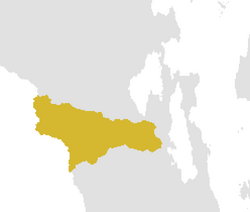Jilachi Desert
This article is incomplete because it is pending further input from participants, or it is a work-in-progress by one author. Please comment on this article's talk page to share your input, comments and questions. Note: To contribute to this article, you may need to seek help from the author(s) of this page. |
| Jilachi Desert | |
|---|---|
 Sand dunes in the Jilachi Desert near Aztlán. | |
 Extension of the Jilachi Desert in Gran Rugido | |
| Ecology | |
| Realm | Neotropical |
| Biome | Deserts and xeric shrublands |
| Borders | Valle de Laura, Valle de la Calma, Estepas del Sur. |
| Geography | |
| Area | 355,600 km2 (137,300 sq mi) |
| Country | Gran Rugido |
| State | Xayacatlán, Senora, and Córdoba. |
| Rivers | Xocoyotzin, Apan, Utapau. |
| Conservation | |
| Conservation status | Relatively Stable/Intact |
| Protected | 51% |
The Jilachi Desert (Spanish: Desierto de Jilachi) is a South Olivacian desert and ecoregion that covers large parts of the center portions of Gran Rugido and the states of Senora, Xayacatlán as well as Córdoba. It is one of the hottest deserts in Olivacia, covering an estiamte 355,600 square kilometers (137,300 sq mi). The Jilachi Desert in phytogeography, is within the Senoran Floristic province of the Calm Region of eastern South Olivacia, part of the Neotropical realm of the southern Eastern Hemisphere. The desert contains a variety of unique endemic plants and animals, notably, the saguaro and organ pipe cactus. Historically, the Jilachi region provides subtropical warmth in winter and two seasons of rainfall creating an extreme contrast between aridity and moisture. However, since the industrailization and issues with global warming, historical areas of the desert have come to create dry summers and cold winters as a result of the greenhouse effect. Certain areas however, are still proeminent to this contrast between aridity and moisture.
As of 2021, important cities located within the immediate desert include the capital of San Jorge Xayacatlán, the ever-growing Aztlán, Izalco and Izamal.
Etymology
The earliest names for the Jilachi Desert according to the Pre-Canterian civilizations that inhabited Gran Rugido were:Chalko (Sapinish: Place of Sand). Xalyukatlan (Sapinish: Sand desert) and Xalatlajko (Sapinish: Place in the middle of the sands). The Tarascanian people oftern called this region the bilim and both the Tarascans and the Sapinish cultures acknowledged the hostility and near-impossible survivavility of the desert so it became a place were disgraced warriors were exiled without any basic supplies. The issue even continued after human sacrifice often took care of disgraced warrios, criminals or offenders to the polytheist religions of the Tarascans and the Sapinish.
The namesake Jilachi comes from the Alejandro Jilachi de Grijalva, one of the very first Canterians to explore the entirety of the desert. Until the XIX Century, the desert was still refered as Xayacatlán o Xalco. Investigator and descendant of Jilachi de Grijalva, Bruno Grijalva suggested the name Desierto de Jilachi to president Ángel Lenoci as a homage to the Canterian explorer.